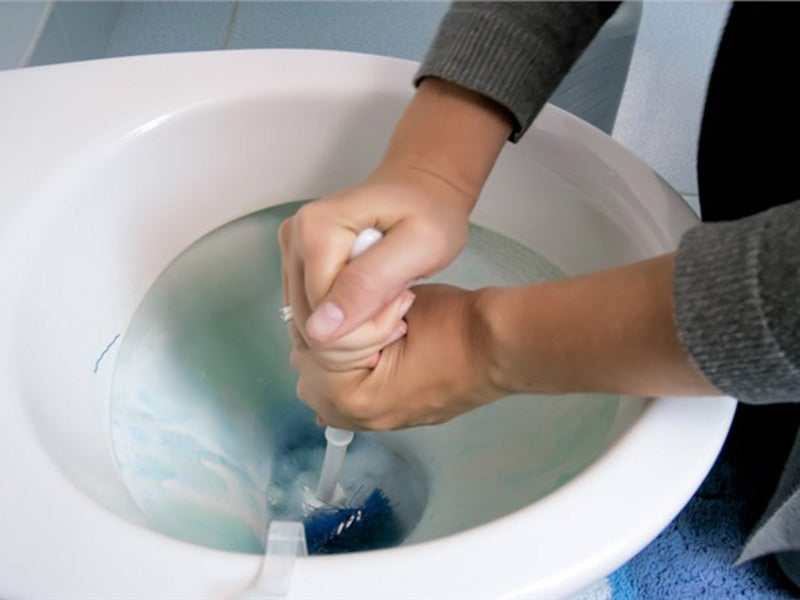A black ring in your toilet often results from mold or mineral deposits. Hard water and infrequent cleaning exacerbate this issue.
A persistent black ring in your toilet can be both unsightly and concerning. Mold, mildew, or mineral deposits usually cause this problem. Hard water, rich in minerals like calcium and magnesium, leaves deposits that create stains. Mold thrives in damp, dark environments, and a toilet bowl provides the perfect conditions.
Regular cleaning and maintenance can help prevent these rings. Using a toilet cleaner specifically designed to tackle hard water stains and mold can be highly effective. Keeping your toilet dry when not in use can also reduce mold growth. Understanding the root cause of the black ring is essential for effective long-term solutions.

Credit: www.youtube.com
Common Causes Of Black Rings
Struggling with a black ring in your toilet? You are not alone. Many homeowners face this issue. Let’s explore the common causes of these unsightly black rings.
Hard Water Deposits
Hard water contains high levels of minerals such as calcium and magnesium. When water sits in your toilet, these minerals settle. They form a black ring over time.
Here is a quick breakdown:
- Minerals from hard water accumulate.
- These minerals form deposits.
- Deposits appear as a black ring.
Using a water softener can help reduce these deposits.
Mold And Mildew Growth
Mold and mildew thrive in damp environments. Your toilet bowl is a perfect spot. They grow and form a black ring around the water line.
Here are the steps:
- Water sits in the toilet bowl.
- Mold and mildew start to grow.
- A black ring forms at the water line.
Cleaning regularly with a disinfectant can prevent mold and mildew growth.
Impact Of Water Quality
Understanding the impact of water quality on your toilet is crucial. The water quality can greatly affect the cleanliness of your toilet bowl. Poor water quality often leads to persistent black rings. These rings are not just unsightly, but also a sign of underlying issues.
Mineral Buildup
Mineral buildup is a common problem in many homes. Water often contains minerals like calcium and magnesium. When water evaporates, these minerals stay behind. They form deposits that can lead to a black ring.
These deposits are not easily removed with regular cleaning. Over time, they can become more pronounced. Mineral buildup can also affect the performance of your toilet. It may lead to clogs and other plumbing issues.
Iron And Manganese
Iron and manganese are two minerals that can cause black rings. These minerals are often found in well water. They can leave dark stains in your toilet bowl. The stains are more visible in areas with hard water.
Iron and manganese deposits can be tough to clean. Regular scrubbing might not be enough. These minerals can also cause other problems. They can clog your pipes and damage your fixtures.
To manage iron and manganese, consider using a water softener. This device can reduce the levels of these minerals in your water. It can help keep your toilet bowl clean and free from black rings.
Role Of Toilet Maintenance
Toilet maintenance plays a crucial role in keeping your bathroom clean.
A well-maintained toilet can prevent the formation of a black ring.
Regular care ensures your toilet remains hygienic and free from stains.
Regular Cleaning
Regular cleaning is essential to avoid the black ring in your toilet.
Clean your toilet at least once a week for the best results.
Use a toilet brush to scrub the bowl and under the rim.
Use Of Cleaning Agents
The use of cleaning agents is important in toilet maintenance.
Choose cleaners that are effective against hard water stains and mildew.
Apply the cleaner and let it sit for a few minutes.
Scrub the toilet bowl thoroughly after applying the cleaner.
Flush the toilet to rinse away the cleaner and loosened grime.
You can also use natural cleaning agents like vinegar and baking soda.
| Cleaning Agent | Effectiveness |
|---|---|
| Commercial Cleaners | High |
| Vinegar | Medium |
| Baking Soda | Medium |
Regular cleaning and proper use of cleaning agents can help maintain a clean toilet.
These practices prevent the black ring and ensure a hygienic bathroom.

Credit: www.fourseasonsheatingcooling.com
Environmental Factors
Have you ever wondered why your toilet keeps getting a black ring? Environmental factors play a significant role in this issue. Understanding these factors can help you keep your toilet clean and ring-free.
Humidity Levels
High humidity levels can cause a black ring in your toilet. When the air is moist, it creates the perfect breeding ground for mold and mildew. These microorganisms thrive in humid conditions and can lead to that unsightly black ring.
Use a dehumidifier in your bathroom. It will reduce the moisture levels and help prevent mold growth. Another tip is to keep your bathroom door open after showers. This allows air to circulate and reduces humidity.
Poor Ventilation
Poor ventilation is another environmental factor that contributes to a black ring. Bathrooms with poor air circulation tend to trap moisture. This trapped moisture encourages the growth of mold and mildew in your toilet.
Ensure your bathroom has proper ventilation. Install an exhaust fan to help remove excess moisture. Open windows whenever possible to let fresh air in. This will keep the bathroom dry and mold-free.
| Factor | Solution |
|---|---|
| High Humidity | Use a dehumidifier and keep doors open |
| Poor Ventilation | Install an exhaust fan and open windows |
By addressing these environmental factors, you can keep your toilet clean. No more black rings to worry about!
Preventive Measures
Preventing a black ring in your toilet requires a few simple steps. These steps help keep your toilet clean and fresh. Here are some effective preventive measures.
Water Softening Solutions
Hard water can cause black rings in toilets. Hard water contains minerals like calcium and magnesium. These minerals can leave stains and rings in your toilet.
Using a water softener can help reduce these minerals. A water softener removes calcium and magnesium from the water. This helps prevent black rings from forming.
You can install a water softener in your home. This system treats all the water entering your house. It ensures that only soft water reaches your toilet.
There are different types of water softeners:
- Salt-based water softeners
- Salt-free water softeners
- Magnetic water softeners
Choose the one that best fits your needs. Ensure regular maintenance of the water softener for effective results.
Proper Ventilation
Proper ventilation is crucial for preventing black rings. Poor ventilation can cause moisture buildup. This creates a perfect environment for mold and mildew.
Mold and mildew can form black rings in your toilet. To avoid this, ensure your bathroom is well-ventilated.
Here are some tips for proper ventilation:
- Use an exhaust fan when using the bathroom
- Open windows to allow fresh air to circulate
- Keep bathroom doors open when not in use
Installing a good-quality exhaust fan is very effective. It helps remove excess moisture from the bathroom. Regularly clean the exhaust fan to ensure it works properly.
Following these preventive measures can help keep your toilet clean. You can avoid the hassle of dealing with black rings.

Credit: www.reddit.com
Effective Cleaning Techniques
Effective cleaning techniques are essential for removing black rings in toilets. These rings often result from hard water, mold, or bacteria. Using proper methods ensures a cleaner, healthier toilet.
Natural Cleaners
Natural cleaners offer a safe way to combat black rings. They are eco-friendly and often found in your home. Below are some effective natural cleaning options:
- Baking Soda and Vinegar: Sprinkle baking soda in the toilet bowl, then pour vinegar. Let it sit for 30 minutes. Scrub and flush.
- Lemon Juice: Lemon juice’s acidity helps break down stains. Apply it directly to the ring. Scrub after 15 minutes.
- Tea Tree Oil: Mix a few drops of tea tree oil with water. Spray the solution on the ring. Let it sit, then scrub.
Commercial Products
Commercial products offer quick and effective solutions for stubborn stains. They contain powerful ingredients that target the black ring directly. Consider the following options:
| Product | Usage Instructions |
|---|---|
| Toilet Bowl Cleaner | Apply the cleaner around the bowl. Let it sit for 10 minutes. Scrub and flush. |
| Bleach Tablets | Drop a bleach tablet into the tank. Flush to release the cleaner into the bowl. |
| Stain Removal Powder | Sprinkle the powder in the bowl. Let it sit for 15 minutes. Scrub and flush. |
Both natural and commercial options can effectively remove black rings. Choose the method that best suits your needs and preferences.
When To Call A Professional
Sometimes, cleaning your toilet’s black ring might not be enough. There are cases when professional help is necessary. Knowing when to call a plumber can save you time and frustration.
Severe Stains
If the black ring in your toilet is thick and persistent, it might be beyond DIY solutions. Severe stains can indicate underlying issues like hard water deposits or mold. These problems require specialized cleaning tools and chemicals.
A professional plumber can assess the situation and recommend the best course of action. They have access to industrial-grade cleaners that are more effective than household products.
Recurring Issues
If you clean the black ring and it reappears quickly, it might be time for expert help. Recurring issues often signal deeper problems in your plumbing system. This could include leaks or poor water quality.
A professional can inspect your toilet and plumbing to identify the root cause. They can offer long-term solutions to prevent the black ring from coming back.
Long-term Maintenance Tips
Maintaining a clean toilet can be challenging, especially when dealing with persistent black rings. These rings can be unsightly and unhygienic. Regular maintenance is key to preventing and managing these issues effectively. Here are some long-term maintenance tips to keep your toilet spotless and free from black rings.
Scheduled Cleaning Routine
Establish a scheduled cleaning routine to ensure your toilet stays clean. Regular cleaning prevents the buildup of minerals and bacteria that cause black rings.
- Clean your toilet at least once a week.
- Use a toilet brush and a good disinfectant.
- Focus on scrubbing the bowl, especially under the rim.
- Consider using a pumice stone for stubborn stains.
Incorporate natural cleaning agents for an eco-friendly approach. Vinegar and baking soda can be very effective. Pour vinegar into the bowl and let it sit for 30 minutes. Then scrub and flush. Baking soda helps to deodorize and remove stains.
Regular Plumbing Inspections
Regular plumbing inspections help identify potential issues before they become serious. A thorough inspection can prevent the formation of black rings.
| Inspection Task | Frequency |
|---|---|
| Check for leaks | Every 6 months |
| Inspect water quality | Annually |
| Examine toilet parts | Every 6 months |
Ensure your water is not too hard. Hard water can lead to mineral buildup. Installing a water softener can significantly reduce this issue. Also, replace any faulty parts immediately to maintain optimal functionality.
Frequently Asked Questions
How To Prevent Black Rings In The Toilet?
Clean regularly with a toilet brush and disinfectant. Use vinegar and baking soda to remove stains. Ensure proper ventilation. Avoid hard water buildup with a water softener. Flush frequently to prevent residue.
Why Does My Toilet Keep Getting Black Stains?
Black stains in your toilet are often caused by mold, mildew, or hard water deposits. Regular cleaning helps.
Why Is There A Black Ring Around The Bottom Of My Toilet?
A black ring around the bottom of your toilet is usually caused by mold, mildew, or mineral deposits. Regular cleaning and using a toilet bowl cleaner can help remove and prevent it.
Why Does My Toilet Get A Ring So Fast?
Hard water minerals, mold, and bacteria cause toilet rings. Regular cleaning and water softeners can help prevent buildup.
What Causes Black Rings In Toilets?
Black rings are usually caused by mold, bacteria, or hard water deposits.
Conclusion
A black ring in your toilet can be frustrating. Regular cleaning and proper maintenance can prevent it. Use natural cleaners to avoid harsh chemicals. Addressing hard water and mold issues can also help. By understanding the causes, you can keep your toilet clean and free from black rings.




